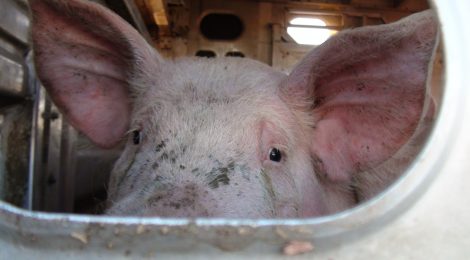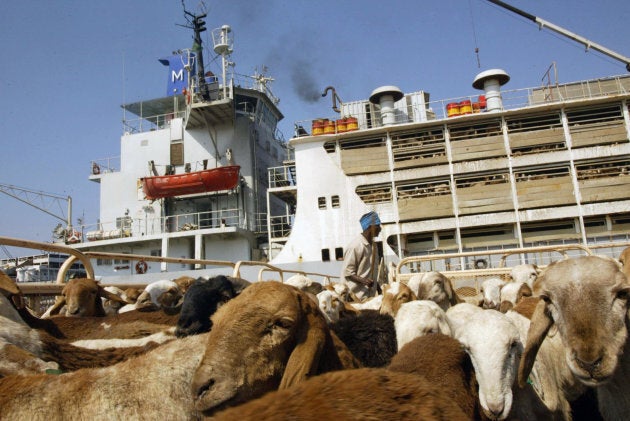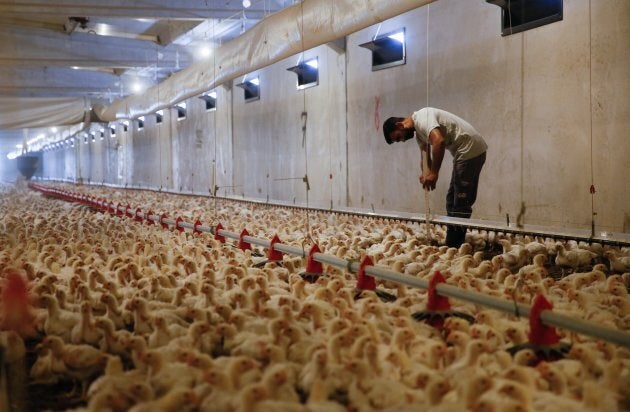
Canada Has Long Exported Animal Cruelty By The Millions
(Original printed in HuffPost Nov 23, 2018; Updated June 14, 2022)
The transportation of farmed animals over long distances, most frequently by ship, has received significant scrutiny from animal advocacy organizations and society in general since the first evidence of what animals endure during the journey began appearing in 2003.
Some organizations, such as Animals Australia, campaign intensively on the issue, releasing disturbing evidence on an annual basis. Footage from that organization’s most recent investigation into sheep destined for the Middle East is harrowing, but typical, showing animals packed so tightly that many could not reach food or water or even lie down to rest. According to Animals Australia, the conditions are ripe for disaster: “extreme heat, exhaustion, rough seas, poor ventilation and millions of litres of untreated waste, and a typical live export voyage quickly becomes the perfect storm for death and suffering.”
Some of the largest exporting countries have ended the practice.
In response to growing public concern and scrutiny, some of the largest exporting countries have ended the practice, sometimes temporarily, sometimes permanently. New Zealand effectively banned live export for the purpose of slaughter in 2007 after it was exposed that 4,000 sheep died on a ship bound for Saudi Arabia some years earlier.
Australian authorities have temporarily suspended live exports to a number of countries, including Saudi Arabia in 2003, Egypt in 2006, Indonesia in 2011, Gaza in 2013, Jordan in 2014, and specific facilities in Vietnam in 2016. Each suspension followed the release of footage showing inhumane transport conditions or horrific abuse in slaughterhouses upon arrival at the country of destination.

The UN’s FAO lists Canada as the 3rd top exporter of live farmed animals in the world.
Although less widely known, Canada is one of the world’s leading exporters of live animals. The UN’s Food and Agriculture Organization data from 2017 lists Canada as the 3rd top exporter of live farmed animals in the world. Based on data from Agriculture Canada, in 2020, Canada exported more than 18.5 million live chickens, turkeys, cattle, pigs and sheep. Poultry accounted for the vast majority at over 12.5 million (with chicks and poults comprising the largest proportion). Other animals, such as cattle, pigs and sheep, who were exported generally to the U.S. for either slaughtering or fattening (with a smaller number destined for breeding), accounted for another nearly six million.
In 2020, Canada exported more than 18.5 million chickens, turkeys, cows, pigs and sheep.
Statistics from the government of Canada (based on the year 2017, the latest available) show that approximately two million animals endured extremely long journeys, travelling thousands of kilometres by ship or cargo plane to countries where few to no animal welfare regulations exist.
The fate of these animals can be roughly broken down into two groups. The first group includes those who are killed immediately upon arrival, such as the 1,708 horses flown to Japan in 2020 whose meat is eaten raw as a delicacy known as basashi, or the sheep and goats who are destined for Singapore and other countries where they are killed in large numbers during annual festivals by having their throats cut while fully conscious.
The second group consists of animals who are exploited for their breeding potential. These include young female pigs sent to China where they are crammed into barren metal and concrete crates in high-rise factory farms and forced to produce piglet after piglet; and young dairy cows transported by ship to Russia and Kazakhstan where they are repeatedly artificially inseminated only to have calf after calf taken from them in order to redirect their milk to humans.
Not included in this already staggering statistic are the nearly 40 million fertilized eggs of various species exported by Canada. Information on what becomes of these birds seems particularly elusive, but may include a delicacy called balut, whereby a bird embryo (usually a duck) close to hatching is boiled alive and eaten from the shell.

The Canadian government announced in its 2017 budget its intention to increase agricultural exports, including live-exports, by 40 per cent by 2025, and according to the updates provided in this article since it was originally published in 2018, Canada is on its way to meeting its target. Canadian politicians and industry leaders are particularly keen on expanding market shares in China. The agricultural press excitedly covers trade mission after trade mission with industry representatives joining federal ministers on expensive trips abroad. Since publishing this piece, live-export has even become part of Canada’s federally owned airports’ development strategies with Edmonton airport openly soliciting “strategic relationships” with Canadian pig breeding companies. Each week, the airport sees 1-2 Boeing 747’s loaded down with 850 to 1,700 breeding pigs which it flies to eastern Europe. Once there, the pigs spend their lives confined to gestation crates, forced to produce litter after litter of piglets.
While countries like England, Australia and New Zealand become increasingly critical of the live export of animals, Canada continues its race to bottom, seeking out new ways to profit off the exploitation of animals.
CETFA Foundation
Copyright © 2022 All Rights Reserved


